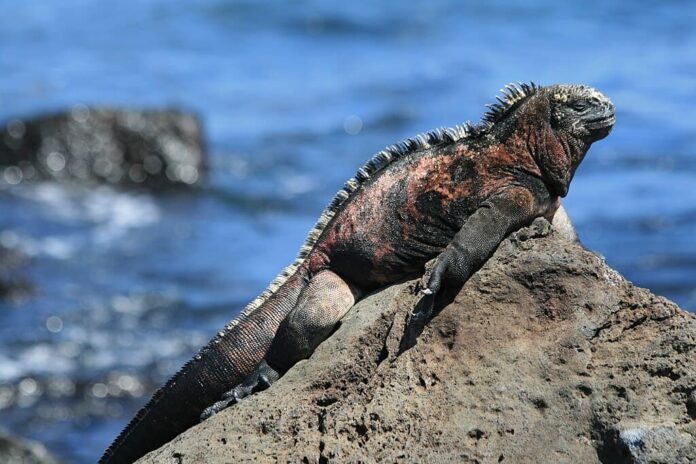Marine iguana is an interesting reptile with many fascinating skills that not many people know about. When in the water, they look like sea dragons foraging for food. From their appearance to their behavior, these saltwater iguanas are definitely one of a kind. Marine iguanas are so unique, especially among modern lizards that we are familiar with. There are many cool things to learn about them, and you will find them all below.
1Appearance
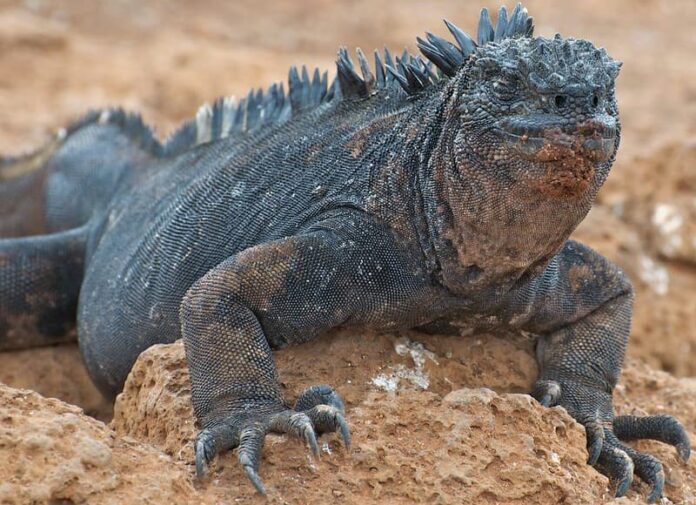
A marine iguana has a pair of wide eyes on their face with spiky scales along its back and tail. Most of them have a dark gray coloring that helps with sunlight absorption after their journey into the seawater. Each island hosts marine iguanas of different and unique colors, shapes, and sizes, and they are all looking really cool. On top of that, marine iguana colorings change in different seasons throughout the year. From January to April which is their mating season, they have bright shades of green, orange, pink, red, and turquoise. If you visit Espanola Island, you will feast your eyes with “Christmas” marine iguanas due to their unique coloring. This bright coloration is simply to attract mates, and they go back to black and gray after the mating season ends.
Marine iguanas have long and sharp claws that they use for clinging to rocks on shore and underwater in heavy currents. Along with that, they have flattened tails that help them to swim easily under the water. The unique thing about marine iguanas is that they have blunt snouts that help them to feed on algae underwater easily. Plus with razor-sharp teeth, they are able to saw off tough seaweed from rocks underwater without a problem. Their sizes are different on various islands based on the amount of food supply available in their areas. A marine iguana can grow up to a length of 1.5 meters (5 feet) which is pretty big.
2Behavior
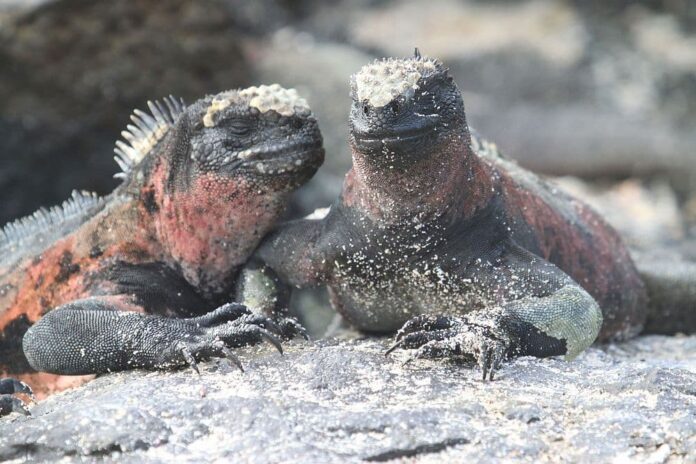
As a marine animal, every iguana in this species is able to dive up to 20 meters (65 feet) underwater. Usually, they spend only a few minutes eating but they can submerge for up to 30 minutes. So can a marine iguana breathe underwater then? No, they cannot. Marine iguanas are not able to do so which is why they can hold their breath for a long time. If they need to, a marine iguana can hold its breath for up to 60 minutes.
Another interesting thing about these marine lizards is the salt glands that allow them to “sneeze” salt out. Marine iguanas feed in the water, and that also means they ingest a large amount of saltwater every day. To prevent dehydration, they expel salt without expelling water by sneezing out the salt. This is why it is common to see salty not all over their faces and necks. Marine iguanas are terrestrial, so that means they live and nest on land. When not feeding, they spend most of their daytime sunbathing on black rocks under the sun. Sometimes they are seen huddling together in large groups as a method of heating up after diving on cold days.
Male marine iguanas will fight for territories, and their method is quite amusing to watch. Two male marine iguanas will have a stare-off while dramatically nodding their heads in a most comical fashion. Then the two will brawl all over each other by butting and pushing one another until one man down. Because they prefer to conserve energy, marine iguanas only bite only to defend their territory. They are not aggressive towards humans, and there haven’t been any records of their attacks either.
3Feeding & Habitat
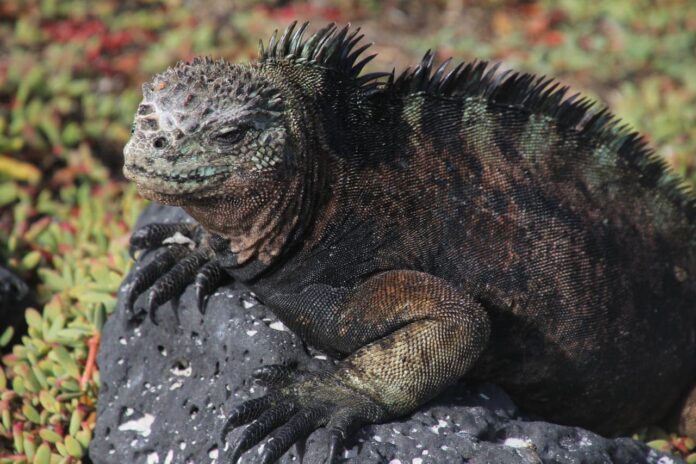
Looking fierce and all, marine iguanas are gentle plant-eaters that never harm anyone. As herbivores, marine iguanas eat marine algae and seaweed that they can find along rocky shores and underwater. One of their amazing abilities is being able to feed in shallow marine waters. When looking for food, a marine iguana swims with a snake-like motion through the water. A super cool ability that this lizard species possess is the ability to shrink in length during El Nino climate events. Its bones become smaller and its skeleton retracts, and it can shrink up to 20% of its body mass. At this time, food availability is not so abundant so marine iguanas become smaller to eat less food. Once the algae that they feed on return to high levels, these iguanas will regain their size back.
Marine iguanas are the only lizards in the world that spend their time in the ocean. This unique species lives only on the Galapagos Islands, with an adaptation to an island lifestyle. These iguanas need sandy terrain to dig burrows, and black lava offers them protection during the day. Along with that, each island also has its own subspecies because their populations have been isolated for so long. These iguanas are also found on rocky shores in most parts of the Galapagos Islands as well. They live in places close to the coastlines and shallow reefs so that they can dive and look for food.
4Predators & Threats
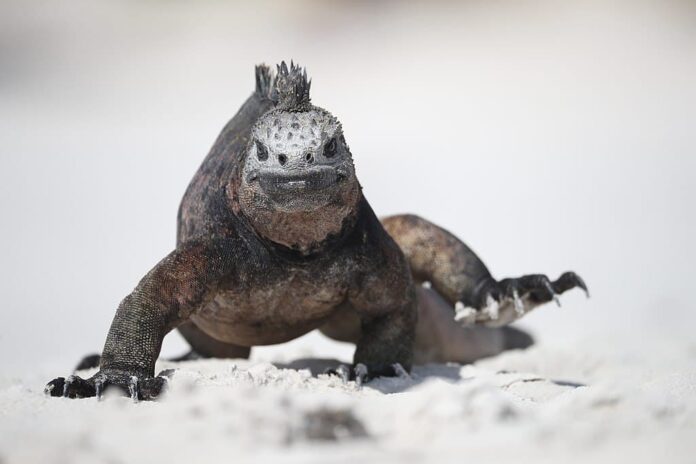
There is a long list of natural predators to baby marine iguanas, but the most common ones are hawks and snakes. These two predators particularly hunt the babies in large numbers during hatching season. You probably have seen one viral video of a lizard being chased by hundreds of snakes on BBC Planet Earth. That was a baby marine iguana escaping from a gang of Galapagos racer snakes. Young marine iguanas face such terrifying challenges every year on Fernandina Island due to the large snake population. Those snakes are just waiting for the hatchings to emerge, and not of those babies are lucky. As for the adult marine iguanas, their main predators are also hawks although they can outrun those predators sometimes.
Although with complete legal protection in the Galapagos Islands, their population is still vulnerable to extinction. There are invasive species that threaten the subspecies marine iguanas on some islands. At the same time, animals like cats, dogs, humans, and pigs attack their eggs and juveniles. There are between 200,000 to 300,000 individuals on the Galapagos Islands at the moment, and the number keeps declining. These problems are difficult to eradicate, and this also means threats to their population still continue to this day.
Related Post: Sea Creatures That Look Like They’re From Sci-Fi Movies

